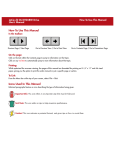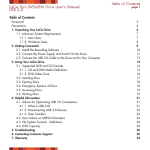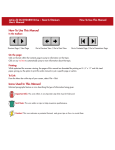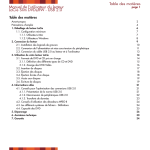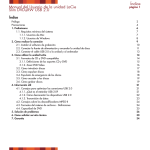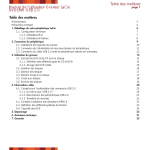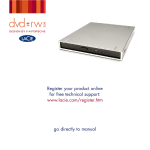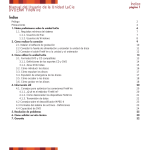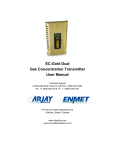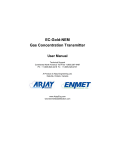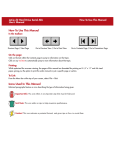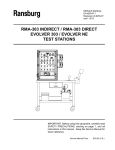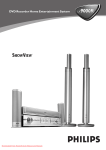Download Product Manual
Transcript
How To Use This Manual LaCie DL DVD±RW Drive User’s Manual How To Use This Manual In the toolbar: Previous Page / Next Page Go to Previous View / Go to Next View Go to Contents Page / Go to Precautions Page On the page: Click on the text within the Contents page to jump to information on that topic. Click on any red text to automatically jump to more information about that topic. Printing: While optimized for onscreen viewing, the pages of this manual are formatted for printing on 8 1/2” x 11” and A4 sized paper, giving you the option to print the entire manual or just a specific page or section. To Exit: From the Menu bar at the top of your screen, select: File > Quit. Icons Used In This Manual Italicized paragraphs feature an icon describing the type of information being given. Important Info: This Tech Note: This Caution! This icon refers to an important step that must be followed. icon refers to tips to help maximize performance. icon indicates a potential hazard, and gives tips on how to avoid them. LaCie DL DVD±RW Drive User’s Manual Table of Contents Table of Contents Foreword Precautions 1. Introduction 1.1. What Your LaCie Drive Can Do 2. Your LaCie Drive 2.1. Minimum System Requirements 2.1.1. Mac Users 2.1.2. Windows Users 3. Installing Your LaCie Drive 3.1. Electrostatic Discharge (ESD) 3.2. Hardware Installation 3.2.1. Mac Users 3.2.2. Windows Users 3.3. Pin Assignments 3.4. Installing The LaCie DVD Utilities 4. Using Your LaCie Drive 4.1. Supported DVD & CD Formats 4.2. Inserting Discs 4.3. Accessing Discs 4.4. Writing Discs 4.4.1. DVD Writing Methods 4.4.2. CD Writing Methods 4.5. Ejecting Discs 4.5.1. Emergency Ejection Of Discs 5. Tech Tips 5.1. DVD & CD Media – Definitions 5.2. File System Formats – Definitions 5.3. DVD Capacity 5.4. DVD-Video Regional Playback Zones 5.5. User Advice On MPEG-2 Decoders 5.6. Device Configuration Jumper Settings 6. Troubleshooting 6.1. Mac Users 6.2. Windows Users 7. Contacting Customer Support 8. Warranty Glossary 3 5 7 7 8 8 8 9 10 10 11 11 14 17 18 19 19 20 20 21 21 22 23 23 24 24 25 25 26 27 28 29 30 32 35 37 38 LaCie DL DVD±RW Drive User’s Manual Foreword page 3 Copyrights Copyright © 2004 LaCie. All rights reserved. No part of this publication may be reproduced, stored in a retrieval system, or transmitted in any form or by any means, electronic, mechanical, photocopying, recording or otherwise, without the prior written consent of LaCie. Trademarks Apple, Mac, Macintosh and FireWire are registered trademarks of Apple Computer, Inc. Sony and iLink are registered trademarks of Sony Electronics. Microsoft, Windows, Windows 98 SE, Windows Millennium Edition, Windows 2000 and Windows XP are registered trademarks of Microsoft Corporation. All trademarks mentioned in this manual are the property of their respective owners. Changes The material in this document is for information only and is subject to change without notice. While reasonable efforts have been made in the preparation of this document to assure its accuracy, LaCie assumes no liability resulting from errors or omissions in this document, or from the use of the information contained herein. LaCie reserves the right to make changes or revisions in the product design or the product manual without reservation and without obligation to notify any person of such revisions and changes. Federal Communications Commission Radio Frequency Interference Statement (FCC) WARNING: Changes or modifications to this unit not expressly approved by the LaCie DL DVD±RW Drive party responsible for compliance could void the user’s authority to operate the equipment. This equipment has been tested and found to comply with the limits for a Tested To Comply Class B digital device, pursuant to Part 15 of the FCC Rules. These limits are With FCC standards designed to provide reasonable protection against harmful interference when the equipment is operated in a commercial environment. This equipment generates, uses, FOR HOME OR OFFICE USE and can radiate radio frequency energy, and if not installed and used in accordance with the instructions, may cause harmful interference to radio communications. However, there is no guarantee that interference will not occur in a particular installation. If this equipment does cause harmful interference to radio or television reception, which can be determined by turning the equipment off and on, the user is encouraged to correct the interference by one of the following measures: • Reorient or relocate the receiving antennas. • Increase the separation between the equipment and the receiver. • Connect the equipment into an outlet on a circuit different from that to which the receiver is connected. • Consult the reseller or an experienced radio/TV technician for help. Shielded cables and I/O cards must be used for this equipment to comply with the relevant FCC regulations. This device complies with Part 15 of the FCC rules. Operation is subject to the following two conditions: (1) this device may not cause harmful interference, and (2) this device must accept any interference received, including interference that may cause undesired operation. LaCie DL DVD±RW Drive User’s Manual Foreword page 4 Canada Compliance Statement This Class A digital apparatus meets all requirements of the Canadian Interference-Causing Equipment Regulations. Manufacturer’s Declaration for CE Certification We hereby certify that this device is in compliance with both the EMC Directive (89/336/EEC) and the Low Voltage Directive (73/23/EEC) issued by the Commission of the European Community. Compliance with these directives implies conformity to the following European Norms: Class B EN60950, EN55022, EN50082-1, EN61000-3-2 With reference to the following conditions: 73/23/EEC Low Voltage Directive 89/336/EEC EMC Directive Laser Products This equipment is certified to comply with DHHS Rule 21 CFR Chapter I, subchapter J in effect as of date of manufacture. This equipment is classified as a Class I Laser product and no hazardous laser radiation is emitted outside the drive. LaCie DL DVD±RW Drive User’s Manual Precautions page 5 Health, Safety and General Use Precautions The drive you have just purchased includes a laser diode device, which classifies it as a "Laser Class I" product. This laser is not dangerous for the user under normal operating conditions. However, we strongly advise you not to place any reflective objects in the disc loading system, due to the risk of exposure to laser emissions that may be reflected by such objects. Always follow the basic precautions listed below to use your LaCie drive safely and correctly. Respecting these guidelines will help to avoid the possibility of personal injury to yourself or others, as well as to prevent damage to your device and other computer equipment. These precautions include, but are not limited to, the following: Health and Safety Precautions: • Read this User's Manual carefully, and follow the correct procedure when setting up the device. • Do not look inside or place your hand over the open DVD/CD media tray. Never look directly or indirectly (with a mirror) at the laser diode, even when the device is not in operation. If you expose your eyes or skin to the laser inside you drive, you risk damage or loss of your vision or other personal injury. • Do not open your drive or attempt to disassemble or modify it. Never insert any metallic object into the drive to avoid any risk of electrical shock, fire, short-circuiting or dangerous emissions. Your drive contains no user-serviceable parts. If it appears to be malfunctioning, have it inspected by qualified LaCie service staff. • Never expose your device to rain or use it near water or in damp or wet conditions. Never place containers on it containing liquids that may spill into its openings. Doing so increases the risk of electrical shock, short-circuiting, fire or personal injury. • Make sure that the computer and drive are electrically grounded. If the devices are not grounded, there is an increased risk of electrical shock. • Do not listen to audio with headphones at an excessive volume for prolonged periods of time. Doing so increases the risk of hearing damage or loss. • Before listening to music with your drive, set the volume control to minimum. Sudden bursts of sound at loud volumes can cause immediate hearing damage or loss. LaCie DL DVD±RW Drive User’s Manual Precautions page 6 General Use Precautions: • Do not expose the drive to temperatures outside the range of 5° C to 40° C (41° F to 104° F) during operation. Doing so may damage the drive or disfigure its casing. Avoid placing your drive near a source of heat or exposing it to sunlight (even through a window). Inversely, placing your drive in an environment that is too cold or humid may damage the unit. • Do not block the ventilation outlets on the rear of the drive. These help to keep your drive cool during operation. Blocking the ventilation outlets may cause damage to your drive and cause an increased risk of short-circuiting or fire. • Always unplug the drive if there is a risk of lightning or if it will not be used for an extended period of time. Otherwise, there is an increased risk of electrical shock, short-circuiting or fire. • Do not place heavy objects on top of the drive or use excessive force on its buttons, connectors and tray. Doing so increases the risk of damage to the device. • Always place your drive in a horizontal position before using it. Otherwise, it may fall, causing damage to the device and / or corruption or loss of data. • Always remove the disc from the disc tray before transporting your drive. Otherwise, written data may be destroyed or the drive's internal components may be damaged. • Never use excessive force on the disc loading system; discs should be inserted effortlessly into your drive. If you detect a problem, consult the Troubleshooting section. • Protect your drive from excessive exposure to dust during use or storage. Dust can build up inside the device, increasing the risk of damage or malfunction. • Never use benzene, paint thinners, detergent or other chemical products to clean the outside of the drive. Such products will disfigure and discolor the front panel and casing. Instead, use a soft, dry cloth to wipe the device. 1. Introduction LaCie DL DVD±RW Drive User’s Manual page 7 1. Introduction Congratulations on the purchase of your new LaCie DL DVD±RW Drive – your complete DVD and CD creation solution! This drive gives you maximum compatibility with the various DVD and CD formats, reading and writing to all of the popular standards (DVD+R/RW, DVD-R/RW and CD-R/RW) and introduces a brand new standard: DVD+R9 Double Layer (DL). Supported DVD and CD Logos DVD+R9 DL Logo DVD+R/RW Logo DVD-R/RW Logo CD-R/RW Logo Double Layer DVD Recording With the same technology that underpins Hollywood-style DVD-Videos, Double Layer (DL) discs are compatible with most consumer set-top DVD players and computer DVD-ROM drives. On one DVD+R9 DL disc, you’ll be able to store up to four hours of MPEG-2 video, sixteen hours of VHS-quality video or increase the video bit rate for higher quality movies. And with 8.5GB of storage space on a single DL disc, they’re ideal for archiving and backup applications, and could even be used as replacement for tape in some instances. Now you have the tools to make high-impact, professional quality DVD videos, conveniently make system backups and preserve all of your memories for the future. 1.1. What Your LaCie Drive Can Do • Burn videos for playback on computers and DVD players • Play, edit, organize and burn your digital music • Save large data projects or make backups 2. Your LaCie Drive LaCie DL DVD±RW Drive User’s Manual page 8 2. Your LaCie Drive Tech Note: Mac Users! DVD Playback: 2.1. Minimum System Requirements 2.1.1. Mac Users Hardware Requirements – Available 5.25” drive bay. System Requirements – Double Layer Recording • 8.5GB Double Layer disc • 700MHz G4 or later • Mac OS 10.2 or later • 64MB of RAM (256MB is recommended) • QuickTime 6 or later At the time of publication (May, 2004), Apple only supports DVD playback on Macintosh computers with a built-in DVD-ROM drive. If your system does not have a built-in DVD-ROM drive, in order to enable DVD playback you will need to utilize a third-party utility. Apple Disc Recording Updater: In order to provide maximum compatibility with Apple software products, LaCie is constantly providing drive support updates. Visit our Web site, www.lacie.com/support, choose Optical from the pull-down menu and download the LaCie DiscRecording Support for Mac OS X 10.3.2 or later to add LaCie drive support to Important Info: MPEG encoding is a system intensive application and applications that utilize Apple’s requires most of a CPU’s power. This process can take several hours on DiscRecording framework. These slower systems. include, but are not limited to, the following applications: Finder, iTunes, Additional Requirements for DVD playback and Pre-Mastering – iPhoto, Backup, Disk Utility and DVD Monitor resolution of 1024 x 768, 24-bit color Studio Pro. Single Layer Recording • 4.7GB Single Layer disc • 700MHz G4 or later • Mac OS 9.1 or later • 16MB of RAM (24MB is recommended) • QuickTime 4.0 or later Additional Requirements for DV Capturing and DVD Authoring – Minimum of 128MB of RAM (256MB is recommended) 1GB of free hard disk space for every 5 minutes of DV video capture 4.5GB of free hard disk space for copying a single layer DVD-Video disc 8GB of free hard disk space for copying a double layer DVD-Video disc Important Info: To ensure optimal recording results, avoid copying from a CD or DVD and record directly from a hard drive that supports sustained data transfer rates for the following speeds: • 8x = 11.08MB/s • 4x = 5.54MB/s • 2x = 2.77MB/s • 1x = 1.385MB/s 2. Your LaCie Drive LaCie DL DVD±RW Drive User’s Manual page 9 2.1.2. Windows Users Hardware Requirements – Available 5.25” drive bay. System Requirements – Double Layer Recording • 8.5GB Double Layer disc • Windows 2000 (SP4 or later) or XP (SP1 or later) • 500-MHz Intel® Pentium III or equivalent • 128MB of RAM (256MB is recommended) Single Layer Recording • 4.7GB Single Layer disc • Windows 98SE, Me, 2000 or XP • 500-MHz Intel Pentium III or equivalent • 128MB of RAM Important Info: MPEG encoding is a system intensive application and requires most of a CPU’s power. This process can take several hours on slower systems. Additional Requirements for DVD Playback and Pre-Mastering – SVGA video card supporting DirectDraw Standard Sound Blaster compatible sound card Microsoft DirectShow 6.4 or greater Monitor resolution of 1024 x 768, 24-bit color Additional Requirements for DV Capturing and DVD Authoring – Minimum of 128MB of RAM (256MB is recommended) 1GB of free hard disk space for every 5 minutes of DV video capture 4.5GB of free hard disk space for copying a DVD-Video disc 8GB of free hard disk space for copying a double layer DVD-Video disc Additional Requirements for Roxio Easy CD & DVD Creator and Easy Media Creator – Easy CD & DVD Creator Easy Media Creator Video Editing Intel Pentium III 500-MHz or faster Intel Pentium III 1.2-GHz or faster DV/Analog to MPEG encoding Intel Pentium III 800-MHz or faster Intel Pentium III 1.2-GHz or faster Important Info: To ensure optimal recording results, avoid copying from a CD or DVD and record directly from a hard drive that supports sustained data transfer rates for the following speeds: • 8x = 11.08MB/s • 4x = 5.54MB/s • 2x = 2.77MB/s • 1x = 1.385MB/s LaCie DL DVD±RW Drive User’s Manual 3. Installing Your LaCie Drive page 10 3. Installing Your LaCie Drive 3.1. Electrostatic Discharge (ESD) Caution! Before handling and installing your LaCie DL DVD±RW Drive, ensure that you have properly grounded yourself. Electrostatic Discharge (ESD) can quickly and easily damage or destroy your component or your computer. Please read the following information to properly ground yourself. Static electricity is an electric charge caused by an imbalance of electrons on the surface of a material. When you touch an object and are shocked, this is the transfer of the static charge or the balancing of your charge to that of the object. This exchange is called Electrostatic Discharge or ESD. ESD can cause two different types of damage to computers and peripherals: (1) Catastrophic, which is the complete loss of device functionality, and (2) Latent Defect, where the device is only partially effected, and the device loses part of its productivity and longevity. Because we cannot eliminate the generation of static electricity, it is extremely important to follow the proper steps to ground yourself before handling your LaCie DL DVD±RW Drive or touching any internal component of your computer. This can be accomplished by proper grounding in conjunction with the use of ESD safe mats, wrist or shoe straps. Consult your computer supply specialist for more details on the correct ESD dissipative device to fit your needs. LaCie DL DVD±RW Drive User’s Manual 3. Installing Your LaCie Drive page 11 3.2. Hardware Installation Tools: Philips-head and/or flat-head screw driver Computer System Manual It is extremely important that you reference your computer system’s manual when installing your LaCie DL DVD±RW Drive. The installation steps that follow are generic steps, and may not directly reflect the unique configurations that are specific to your particular computer system. Important Info: 3.2.1. Mac Users 1) Turn off your computer and disconnect all external peripheral devices and cables, i.e. power cord, modem/fax line, monitor, etc. 2) Remove your computer by pulling the cover latch, and then gently set the side cover down on a non-abrasive surface. LaCie DL DVD±RW Drive User’s Manual 3. Installing Your LaCie Drive page 12 3) Once you have removed the cover, you will need to remove the CD-ROM assembly front bezel. The removal of the CDROM front bezel assembly will vary, so please refer to your computer system’s manual for specific details. 4) Disconnect the IDE Interface, Power and Audio cables from your existing CD-ROM drive. Some Macs may not have an Audio cable, please consult your computer system’s manual for specific details. 5) Remove the existing drive’s mounting screws, then remove the old drive and mount your LaCie DL DVD±RW Drive in its place. Please refer to your computer system’s manual for specific details. 6) Next, set the LaCie DL DVD±RW Drive’s Device Configuration Jumper: When using one IDE interface cable, place the Device Configuration Jumper on the Slave setting, as shown here: Slave Configuration When using two IDE interface cables and there is only one DVD-R/RW drive, place the Device Master Configuration Configuration Jumper on the Master setting, as shown here: The LaCie DL DVD±RW Drive is pre-configured to the Master setting. When using two IDE interface cables and there are two DVD-R/RW or another CDROM/R/RW drive, place the Device Configuration Jumper on the Slave setting. For a more detailed discussion of the Device Configuration Jumper, please see 5.6. Device Configuration Jumper Settings. Important Info: 3. Installing Your LaCie Drive LaCie DL DVD±RW Drive User’s Manual page 13 7) Next, you will have to connect the drive’s power, IDE and audio cables, as shown in the figures here: Connect the cables in the following order: A Connect the power cable from the computer to the DVD drive, paying close attention to the polarity of the cable. B Connect the IDE interface cable. Make sure that Pin 1 on the drive corresponds to Pin 1 on the cable. C Connect the drive’s audio cable between the sound output terminal on the drive and the audio output terminal on the sound card. A C B A 9) Now you are ready to put the computer’s cover back on and reconnect all of your external peripheral devices and cables. LaCie DL DVD±RW Drive User’s Manual 3. Installing Your LaCie Drive page 14 3.2.1. Windows Users Important Info: Due to the wide variety of computer system manufacturers and varying case designs, it is extremely important that you reference your computer system’s manual when installing your LaCie DL DVD±RW Drive. The installation steps that follow are generic steps, and may not directly reflect the unique configurations that are specific to your particular computer system. 1) Turn off your computer and disconnect all external peripheral devices and cables, i.e. power cord, modem/fax line, monitor, etc. 2) Remove your computer’s cover. For most computers, there are screws that will need to be unseated before you can remove the computer’s cover, and these screws are usually located at the rear of the computer, along the edge of the cover. However, placement of these screws and cover attachment may vary by manufacturer, so please refer to your computer system’s manual for specific details. 3) Once you have removed the cover, you may need to remove the front bezel of your computer case. The removal of the front bezel of the computer case will vary dependant upon manufacture, so please refer to your computer system’s manual for specific details. 4) Remove the cover from the empty drive bay. Please refer to your computer system’s manual for specific details. 5) Insert the LaCie DL DVD±RW Drive into the available drive bay by sliding it into the front of the drive cage, as shown below. 6) Match up the screw holes on either side of the drive with the screw holes on your computer’s chassis, as shown above. You may need to attach a horizontal bracket to both sides of the drive to ensure that the drive fits properly. Use of the brackets will depend on your computer model. Consult your computer system’s manual for further details. 7) Insert two screws into each side of the drive and tighten. LaCie DL DVD±RW Drive User’s Manual 3. Installing Your LaCie Drive page 15 8) Next, set the LaCie DL DVD±RW Drive’s Device Configuration Jumper: When using one IDE interface cable, place the Device Configuration Jumper on the Slave setting, as shown here: When using two IDE interface cables and there is only one DVD-R/RW drive, place the Device Configuration Jumper on the Master setting, as shown here: Slave Configuration Master Configuration The LaCie DL DVD±RW Drive is pre-configured to the Master setting. When using two IDE interface cables and there are two DVD-R/RW or another CDROM/R/RW drive, place the Device Configuration Jumper on the Slave setting. For a more detailed discussion of the Device Configuration Jumper, please see 5.6. Device Configuration Jumper Settings. Important Info: 3. Installing Your LaCie Drive LaCie DL DVD±RW Drive User’s Manual page 16 9) Next, you will have to connect the drive’s power, IDE and audio cables, as shown in the figures here: Connect the cables in the following order: A Connect the power cable from the computer to the DVD drive, paying close attention to the polarity of the cable. B Connect the IDE interface cable. Make sure that Pin 1 on the drive corresponds to Pin 1 on the cable. C Connect the drive’s audio cable between the sound output terminal on the drive and the audio output terminal on the sound card. A C B A 10) Now you are ready to put the computer’s cover back on and reconnect all of your external peripheral devices and cables. LaCie DL DVD±RW Drive User’s Manual 3. Installing Your LaCie Drive page 17 3.3. Pin Assignments Audio Output Pin 1 2 3 4 Name L G G R Function Left channel audio output Ground Ground Right channel audio ouput Device Configuration Jumper Pin 1 2 3 4 5 Name MA* SL CS Function On – Drive set to Master mode On – Drive set to Slave mode On – Drive set to Cable Select mode Reserved Reserved *Pin #1 is active upon initial shipment. For a more detailed discussion of the Device Configuration Jumper, please see 5.6. Device Configuration Jumper Settings. Important Info: DC Input Pin 1 2 3 4 Name +12 G G +5 Function Power supply input for DC +12 V Ground Ground Power supply input for DC +5 V 3. Installing Your LaCie Drive LaCie DL DVD±RW Drive User’s Manual page 18 3.4. Installing The LaCie DVD Utilities Insert your LaCie DVD Utilities CD-ROM into your internal DVD/CD-ROM, and follow the instructions below that are based on each particular operating system. For more information about the various programs, please refer to the Help sections of the specific software program. Mac Users: D Util VD itie s Mac OS 10.2 and later – Double-click the the LaCie DVD Utilities CDROM icon and then open the “Roxio Toast Lite” folder. Drag and drop the Roxio Toast Lite 6.x.x.L application icon into the Applications folder on your hard drive. Mac OS 9.1 and later – Double-click the the LaCie DVD Utilities CDROM icon and then open the “Roxio Toast Lite” folder. Click on the Roxio Toast Lite 5.2.2L icon on follow the on-screen instructions to complete the installation. Important Info: Mac OS 9.1 and later does not support double layer recording. Windows Users: Windows 2000/XP – Click on Easy Media Creator and DVDMax Player (separately) and follow the on-screen instructions to complete the installation. Windows 98SE/Me – Click on Easy CD & DVD Creator and DVDMax Player and follow the on-screen instructions to complete the installation. Important Info: Windows 98SE/Me do not support double layer recording. 4. Using Your LaCie Drive LaCie DL DVD±RW Drive User’s Manual page 19 4. Using Your LaCie Drive 4.1. Supported DVD/CD Formats Your LaCie drive is compatible with most popular DVD and CD formats: Format Type of Disc Record DVD DVD+R9 DL X DVD+R X DVD+RW X DVD-R 4.7GB for General use (Ver. 2.0) X DVD-ROM -DVD-R 3.95GB, 4.7GB for Authoring -DVD-R (General use only for write) X DVD-RW (General use only for write) X DVD-ROM (single and dual layer) -DVD (single and dual layer) 80 mm disc -CD CD-R X CD-RW (supports AM2) X CD-ROM -CD-ROM XA Mode2 (form 1, form 2) -CD-Extra -- Read X X X X X X X X X X X X X X X Tech Note: When recording video, audio or data to DVD+R9 DL, DVD+R/RW, DVD-R/RW or CD-R/RW media, LaCie recommends that you use media from one of the following manufacturers: • LaCie • Apple • Taiyo Yuden • Sony • TDK • Verbatim • Ricoh Ideal recording techniques: • Close all other open programs and disconnect from the internet; • Copy data to your hard drive first; • Use the correct media with the appropriate speed rating; • Use media that is free of scratches and fingerprints; Check LaCie’s Web site (www.lacie.com) often for the latest information on creating CDs and DVDs. 4. Using Your LaCie Drive LaCie DL DVD±RW Drive User’s Manual page 20 4.2. Inserting Discs 1 2 ReWritable 4 3 1 Media Tray 2 Open/Close Button 3 Activity LED 4 Emergency Eject Hole Fig. 4.2 To insert a disc push the Open/Close (#2) button on your LaCie DL DVD±RW Drive. When the disc tray opens, put the DVD or CD media into the tray with the label side facing up. Make sure the DVD or CD is correctly placed in the center of the disc tray. Gently push in the disc tray or push the Open/Close button to close it. Do not attempt to force the tray open, you will damage the drive. The power must be on in order to open the drive. The drive must be on a flat surface to work correctly. To close your LaCie DL DVD±RW Drive, press the Open/Close button on the front of the drive. Caution! • Do not force the tray closed. You will damage the drive. • Always remove discs before transporting the drive. 4.3. Accessing Discs Windows Users The CD or DVD volume will appear in My Computer. Click on My Computer to view the contents of the CD or DVD and to have access to the folders and files on it. You can also gain access to the files and folders contained on the disc by going into Windows Explorer and clicking on the CD/DVD-ROM drive icon. Mac Users The CD or DVD volume will appear as an icon on the Desktop. Click on the icon to have access to the contents of the CD or DVD. LaCie DL DVD±RW Drive User’s Manual 4. Using Your LaCie Drive page 21 4.4. Writing Discs The following is a brief overview of some of the recording terminology to help you understand how to use your drive to write discs. Important Note: Please refer to your recording software’s user's guide for information on how to best use your LaCie DL DVD±RW drive in write mode. 4.4.1. DVD Writing Methods Disc at Once (DAO) – A DVD writing process in which the entire DVD is recorded in one session, and data cannot be added after the recording is finished. Differs from the CD-R DAO method because the lead-in, data area and lead-out areas are all written sequentially. Incremental Recording (IR) – A DVD writing process that is similiar to the Session at Once (SAO) CD-R writing method; files may be added directly to the DVD-R disc one recording at a time, instead of recording the files to a hard drive before writing the disc. The minimum recorded size, though, must be at least 32KB (even if the file to be recorded is smaller than that), and capacities and write speeds are decreased due to the overhead of combined lead-in/out areas and data. Also, the disc must be finalized before it may be played back by a drive other than the drive recording the disc. Multi-Border Recording (MBR) – A DVD writing process that is very similiar to IR, MBR allows you to make an IR disc and then play the disc back on a device that recognizes this type of recording method. MBR creates a very short boundary zone around a recording session so a compatible player or DVD-ROM drive does not attempt to play beyond the border of the recorded area, instead allowing the unfinalized disc to be read by a player that supports this recording method. Restricted Overwriting (RO) – A DVD writing process that only applies to DVD+/-RW discs. With this method, if a disc has already been written to, new data segments can be randomly inserted anywhere within the recorded boundary. New data, however, can only be added to an area of the disc that has already been recorded over and from the point where the last session was stopped. Session at Once (SAO) – A DVD writing process which is similar to DAO, where all of the information is written in one session, but SAO allows for the ability to begin another session and record at a later time. This mode allows for greater control of the recording process than Packet Writing (PW) or TAO, and more disc space can be utilized because there is no need for gaps between tracks. Packet Writing (PW) – A writing process that is very useful for data backup. Buffer underrun* is impossible in this mode, because the data is written in “packets” of a few KBs. LaCie DL DVD±RW Drive User’s Manual 4. Using Your LaCie Drive page 22 4.4.2. CD Writing Methods Disc at Once (DAO) – A CD writing process in which the entire CD is recorded in one session, and data cannot be added after the recording is finished. This mode allows for the most control of the recording process for audio CDs because the gap between tracks can be set and the maximum capacity of the CD can be utilized. Packet Writing (PW) – A CD writing process that is very useful for data backup, but cannot be used to write audio CDs. Buffer underrun* is impossible in this mode, because the data is written in “packets” of a few KBs. Session at Once (SAO) – A CD writing process which is similar to DAO, where all of the information is written in one session, but SAO allows for the ability to begin another session and record at a later time. This mode allows for greater control of the recording process than PW or TAO, and more disc space can be utilized because there is no need for gaps between tracks. Track at Once (TAO) – A CD writing process where data is added one track at a time, and the data can be added at a later time. The CD being written to, though, can only be read in the CD rewritable drive that is recording it until the disc is finalized (meaning that no more data can be added). There is also a gap of 2 seconds added between tracks, which will be heard as noise in some audio players. Tech Note: *Buffer Underrun – The recording of a disc is a system-intensive application, and the rewritable drive needs a constant stream of data. A buffer underrun occurs when the stream of data to the rewritable drive is not fast enough to keep the rewritable drive’s buffer full, causing the an error in the recording process. If this problem occurs often, turn down the recording speed. LaCie DL DVD±RW Drive User’s Manual 4. Using Your LaCie Drive page 23 4.5. Ejecting Discs Do not attempt to open the drive's disc tray or remove the DVD or CD while the unit is in use and being accessed by the computer. You may injure yourself, and damage the drive and/or your computer system. Do not transport the drive with the tray open or with a DVD or CD disc inside it. Doing so may damage the drive and/or data stored on the disc, and will void your warranty. Caution! Windows Users After you have finished using the drive and the computer is no longer accessing it, push the Open/Close button (Fig.4.2 #2). When the disc tray is fully open, remove the DVD or CD. After removing the disc, gently push in the disc tray or push on the Open/Close button to close it. You can also go into My Computer and right-click the drive icon. In the drop-down menu that follows, select the Eject option. The disc tray will open, then you can access your media. Mac Users Drag the DVD/CD icon on the desktop to the Trash. The drive's tray will then open. Remove the DVD or CD. Gently push in the disc tray or push the Open/Close button to close it. 4.5.1. Emergency Ejection of Discs In the event that a CD or DVD cannot be ejected with the Open/Close button and the software is not controlling the drive, use the emergency eject operation to open the disc tray. First, switch off your computer and the drive and unplug the drive's power. Caution! Make sure the drive is off and the power unplugged before attempting the emergency ejection procedure. On the front of the drive is the Emergency Eject Hole (Fig.4.2 #2). Insert a small metal poker, such as an unbent paper clip, into the Emergency Eject Hole until the poker presses against the manual eject mechanism. You will feel the mechanism eject the disc tray. Only use this method when the Open/Close button is not working. LaCie DL DVD±RW Drive User’s Manual 5. Tech Tips page 24 5. Tech Tips 5.1. CD and DVD Media Definitions Your LaCie DL DVD±RW Drive will let you create, save and share your digital files to CD-R/RW, DVD-R/RW, DVD+R/RW and DVD+R9 DL media. Please refer to section 2.1. Minimum System Requirements and your recording software’s documentation to see which recording techniques your computer supports. DVD+R9 DL Discs: • Best suited for: recording high-quality DVD videos, backing up systems and archiving large data DVDs. • These discs follow the DVD+ recording techniques, but with 8.5GB of capacity versus 4.7GB for DVD±R discs. • With the increased capacity, it is now possible to increase the video bit rate for higher quality DVD videos. DVD+R Discs: • Best sutied for: recording DVD videos, storing multiple photo albums and data DVDs under 4.7GB. • These discs have the same write-once concept as CD-R media, but with 4.7GB of capacity versus 700MB for CD-R discs. • DVD+R supports “lossless linking” and the combination of Constant Angular Velocity (CAV) and Constant Linear Velocity (CLV) recording techniques. DVD+RW Discs: • Best sutied for: backing up and archiving digital content. • These discs are functionally similiar to CD-RW and DVD-RW discs, but utilizes the same recording techniques as DVD+R. • Incorporates the Direct Overwrite (DOW) system, allowing data to be written directly over existing data in a single pass. DVD-R Discs: • Best sutied for: recording DVD videos, storing multiple photo albums and data DVDs under 4.7GB. • These discs are also functionally similiar to CD-R media, and have the same capacity as DVD+R discs. • There are two types of DVD-R discs: DVD-R General, which are intended for home applications, and DVD-R Authoring, which are intended for professional DVD-Video development applications. DVD-RW Discs: • Best sutied for: backing up and archiving digital content. • These discs serve the same general purpose as CD-RW media, but with 4.7GB of space versus 650MB. • Discs can be written and erased up to 1,000 times. CD-R Discs: • Best sutied for: recording audio CDs, store photos and data CDs. • Files can not be deleted from CD-R discs, and you cannot write over existing files on a CD-R disc. CD-RW Discs: • Best suited for: passing medium sized files around an office or among students. • Discs can be reformated up to 1,000 times, and files can be written over. • Most CD-ROM drives and audio CD players cannot read CD-RW discs. LaCie DL DVD±RW Drive User’s Manual 5. Tech Tips page 25 5.2. File System Formats - Definitions When writing DVD+R9 DL, DVD±R/RW and CD-R/RW discs, you will have the option to assign the disc a particular file format (the way in which a computer names and organizes files for storage and retrieval). There are essentially three file system formats to be concerned with when using a LaCie DVD or CD Drive: • Universal Disk Format (UDF) • ISO 9660 • Mac OS Extended UDF – This file system was developed to ensure consistency between various optical media, compatibility across platforms and among various CD and DVD applications. UDF is used by DVD to contain MPEG audio and video streams, and is required by DVD-ROMs. ISO 9660 – This is the standard file system for CD-ROMs, which allows them to be read on a Mac, PC or other major computer platform. Microsoft created an extension to the format, called Joliet, which allows for Unicode file character names and file names up to 64 characters in length (twice as many as the ISO 9660 Level 2 and 3 specifications). Mac OS Extended – Also known as HFS+, this is the file system used by Mac OS 8.1 and higher. If you will be using your disc only on Macs, this is the preferred file format. 5.3. DVD Capacity There are important factors to consider when recording video, audio or data to DVD. The DVD media specification provides for two physical sizes: 4.7” (12cm) and 3.1” (8cm) (both are .47” (1.2cm) thick). DVD discs can also be single-sided (SS) or double-sided (DS), and each side can have one (SL) or two (DL) layers of data. The amount of data or video that a disc can hold are dependent upon factors such as the amount of audio and the degree of compression of the data, video or audio. For example, a single-layer DVD±R disc typically will store just over two hours of MPEG-II video, but it is possible to put up to eight hours of VHS-quality video or one hundred sixty hours of audio on a single-layer disc. When media companies reference the amount of data that a disc can hold, they represent the total amount in terms of gigabytes (GB), or a billion bytes (1000 x 1000 x 1000 bytes). This number, though, is not the way in which a computer addresses the data; to a computer the value is binary and larger than a billion bytes – 1,073,741,824 (1024 x 1024 x 1024 bytes). Therefore, when you put in a 4.7GB DVD disc, the actual available capacity is 4.38GB; and a 8.5GB Double Layer disc has an actual available capacity of 7.95GB. LaCie DL DVD±RW Drive User’s Manual 5. Tech Tips page 26 5.4. DVD-Video Regional Playback Zones Nearly all commercially-available DVD discs feature a Region Protection Code (RPC). In order to watch DVD-Video discs, the RPC needs to match the setting on the DVD player. By default, all LaCie DVD-Video-compatible drives are set to the RPC zone of the country in which it was purchased. This RPC setting may be changed using your hardware or software MPEG-II decoder (please refer to the documentation supplied with your decoder for more information). DVD-Video discs that do not feature RPC II encoding may be played on all DVD players set to Zone 1. The worldwide RPC zones are: Zone 1 USA and Canada Zone 2 Europe, Japan, the Middle East and South Africa Zone 3 Southeast Asia (including Hong Kong) Zone 4 Australia, New Zealand, Central and South America Zone 5 Northwest Asia, North Africa Zone 6 China When you insert a DVD-Video disc into your drive for the first time, the hardware or software MPEG-II decoder will detect if the setting of your drive is the same as on the DVD-Video. If not, a message will appear on your screen and you will be asked to change the RPC setting of your drive. Important Note: You can only change the RPC of your drive four times. The RPC setting is copied into an internal component in the drive. This chip makes an average of the first five readings and sets the drive to the most read zone. After this, it will not be possible to change or reset the RPC of the drive. Example: You change the RPC Zone to play a Zone 1 DVD-Video, and then you change to a Zone 2 DVD-Video. You switch back and forth between the zones a total of five times, twice in Zone 1 and three times in Zone 2. Your drive will then be set on Zone 2, without the possibility to reset the drive later on in order to view DVDVideo discs from Zone 1. LaCie DL DVD±RW Drive User’s Manual 5. Tech Tips page 27 5.5. User Advice On MPEG-2 Decoders All DVD-Video material is compressed using MPEG-2 compression. DVD-Video, with full-motion video and multi-channel sound (multi-lingual soundtracks, surround sound, etc.), is a data-hungry application. Without compression, you would only be able to fit a 5-minute movie onto a 4.5GB disc (the DV format is equivalent to 13GB per hour). MPEG-2 compression allows you to fit a full-length feature film, plus bonus material, on just one disc. In order to play DVD-Video discs using your LaCie d2 DL DVD±RW Drive, you need to have an appropriate MPEG-2 decoder. You have two options: 1) Install the MPEG-2 decoder software if your PC is equipped with a processor that is 400MHz or faster. The decoder software will give you smoother images when playing DVD-Video discs using your drive (as with any application, the more RAM you have, the better playback performance will be). 2) Purchase and install a PCI MPEG-2 decoder card if your PC is equipped with a processor that is 400MHz or slower. The decoder card should help you obtain better performance during playback with your LaCie drive. LaCie DL DVD±RW Drive User’s Manual 5. Tech Tips page 28 5.6. Device Configuration Jumper (Master and Slave) Settings The IDE interface on the back of your LaCie Dual DVD Drive can support two devices, and most computer motherboards come with dual IDE interfaces, primary and secondary, to allow up to four IDE devices. The controller is integrated with the drive, and does not decide which device has priority in communicating with the computer. In allowing for two devices on the same cable, IDE incorporates a unique configuration to allow control of the devices, called Master (MA) and Slave (SL). In this configuration, Master means drive 0, and Slave refers to drive 1, which allows the drives to work independently. Pin 39 on the IDE interface carries a special signal, called the Drive Active/Slave Present (DASP), that allows the computer to determine if there is a second (slave) drive attached. The master drive should be attached to the connector at the very end of the IDE ribbon cable, although it will work in either position. This is where the Device Configuration Jumper settings become very important – the Device Configuration Jumper identifies the drive as either the master or slave drive. The drive’s controller board will look to the Device Configuration Jumper for instructions as to whether it is the master or slave device. The LaCie Dual DVD Drive offers an option as an alternative to the permanent selection of a master or slave – the Cable Select (CS) option. By using a special type of IDE ribbon cable, CS allows the drive to be auto-configured as either slave or master. In CS mode, each device attached to the IDE cable has its jumper set to the CS option. The cable has one important difference from other typical IDE ribbon cables; with a CS IDE ribbon cable, Pin 28 only connects to the master drive connector. This way, when the computer is powered on, the IDE interface sends a signal along the Pin 28 wire, and only the device that is attached to the master connector receives the signal, which then automatically configures the device as the master, leaving the other device as the slave. The Device Configuration Jumpers are the six straight angle pins located on the rear of the drive. The jumper is the tiny, black rectangular piece covering the two vertical pins below the MA letters on the back of the drive. Your LaCie Dual DVD Drive is pre-configured in the factory to the master setting (MA). By removing the jumper on the pins and then placing it on the two vertical CS pins, you can configure the device in the CS mode, or place it on the two vertical SL pins to configure it as the slave device. In most installations, the jumper should remain in the master position. If possible, you should install the LaCie Dual DVD Drive on the secondary IDE bus, using a separate IDE cable. If you will be installing the drive on the primary IDE bus, your hard drive should be set as the master (MA), and the LaCie drive should be set as the slave (SL). LaCie DL DVD±RW Drive User’s Manual 6. Troubleshooting page 29 6. Troubleshooting In the event that your LaCie DL DVD±RW Drive is not working correctly, please refer to the following checklist to find out where the problem is coming from. If you have gone through all of the points on the checklist and your drive is still not working correctly, please have a look at the FAQs that are regularly published on our Web site – www.lacie.com. One of these FAQs may provide an answer to your specific question. You can also visit the drivers pages, where the most recent software updates will be available. If you need further assistance, please contact your LaCie reseller or LaCie Technical Support (see 7. Contacting Customer Service for details). Manual Updates LaCie is constantly striving to give you the most up-to-date, comprehensive User’s Manuals available on the market. It is our goal to provide you with a friendly, easy-to-use format that will help you quickly install and utilize the many functions of your new device. If your manual does not reflect the configurations of the product that you purchased, please check our Web site for the most current version available. These Troubleshooting tips are divided up by operating system: 6.1. Mac Users – click here 6.2. Windows Users – click here 6. Troubleshooting LaCie DL DVD±RW Drive User’s Manual page 30 6.1. Mac Users The Problem The drive is not recognized by the computer. Questions to Ask Does your computer’s configuration meet the minimum system requirements for use with this drive? Possible Solutions Check section 2.1. Minimum System Requirements – Mac Users for more information. Is the drive’s power supply connected and turned on? Make sure that the power supply is properly connected (see section 3.2. Hardware Installation), and that the outlet the power supply is connected to is also turned on. Did you follow the correct installation steps? Review the installation steps under 3.2. Hardware Installation. Is there an icon for the drive appear on the desktop? When there is a CD or DVD disc in the drive, there should be an icon for the LaCie drive on the desktop. Open Apple System Profiler and click on the Devices and Volumes tab. If your device is not listed, follow the rest of the Troubleshooting tips to isolate the problem. Is there a conflict with other device drivers or extensions? Contact LaCie Technical Support for help. DVD-Video playback will not work. Do you have a DVD-ROM, Combo or SuperDrive installed in your computer. At the time of publication (May, 2004), Apple does not support DVD playback over external DVD drives if there is not a DVD drive (DVD-ROM, Combo or SuperDrive) installed in the host computer. If your system does not have a built-in DVD drive, in order to enable DVD playback you will need to utilize a third-party software utility. The drive’s media tray will not open. Have you tried dragging the disc’s icon to the Trash? Drag the disc icon onto the Trash icon. The disc should then eject automatically. If this does not work, try using the eject funtcion of the software program that you are using. Has a running software program If the disc still will not eject, go to section 4.5.1. Emergency locked the eject function? Ejection of Discs for more information on how to eject your media. 6. Troubleshooting LaCie DL DVD±RW Drive User’s Manual The Problem Questions to Ask Is the disc already full? The drive’s media tray automatically ejects a disc when you try to record on it, or the drive is not writing to CD/DVD correctly. Does the drive support the format of the disc you have inserted? page 31 Possible Solutions Verifty the contents of the disc by using your recording software or viewing its contents by going to File and clicking on Get Info. If after checking and it still won’t record, try using another piece of media. Check section 4.1. Supported DVD & CD Formats for information about the different formats supported by your drive. Is the disc damaged? Carefully inspect the disc. Look to see if there are highly visible scratches to the recording surface (the bright, shiny, reflective side) of the disc. If in doubt, try another disc. Has the recording software been installed correctly? Double-check the installation of your recording software and re-install the software, if necessary. Review the recording software’s troubleshooting and help sections for further tips about the recording software. Has buffer underrun occurred (has something interupted the stream of data to the recorder)? For the best recordings, follow these tips to avoid buffer underrun interuptions: • Quit all other running software programs before starting to record so that there are no other programs operating during the recording; • De-activate File Sharing if it is active; • If you are making a direct recording, such as a copy, from a CD or a DVD, make sure that the speed of the drive playing the CD or DVD is fast enough to provide a sufficient data stream to the LaCie drive. When making copies, it is recommended that you transfer the material to be copied to your hard drive, and then make the recording from the data on the hard drive. • Reduce the write speed of the LaCie drive using the appropriate menu in the recording software. 6. Troubleshooting LaCie DL DVD±RW Drive User’s Manual page 32 6.2. Windows Users The Problem Questions to Ask Possible Solutions The drive is not recognized by the computer. Is there an icon for the drive in My Computer? Go into My Computer and look for an icon and drive letter assigned to the LaCie drive. If the drive does not appear, follow the rest of the Troubleshooting tips to isolate the problem. Does your computer’s Check section 2.1. Minimum System Requirements for more configuration meet the minimum information. system requirements for use with this drive? Is the drive’s power supply connected and turned on? Make sure that the power supply is properly connected (see section 3.2. Hardware Installation), and that the outlet the power supply is connected to is also turned on. Did you follow the correct installation steps? Review the installation steps under 3.2. Hardware Installation. Is there a conflict with other device drivers? Contact LaCie Technical Support for help. 6. Troubleshooting LaCie DL DVD±RW Drive User’s Manual page 33 The Problem Questions to Ask Possible Solutions DVD-Video playback does not work. Have you installed the appropriate MPEG-2 software decoder? Ensure that the MPEG-2 software has been installed correctly. See the help section of the software program for more information. Do you have a Pentium II 350 Check your processor (Start > Settings > Control Panel > MHz (or equivalent) processor or System > General tab.) If your processor does not meet the greater? minimum requirements (see section 2.1. Minimum System Requirements), you may need to purchase an MPEG-2 decoder card. Consult your computer supply specialist for details. Has the LaCie drive been set as the default DVD drive in your DVD playback software? Consult the help section of your DVD playback software for information on how to configure your drive as your computer’s default DVD player. Are you running other software programs simultaneously? Check to see if other programs are running. If so, close them. Depending on your computer’s configuration, playback may be possible only if the DVD player software is the only program running. If using Windows, do you have Check your processor (Start > Settings > Control Panel > a Pentium II 350 MHz (or System > General tab.) If your processor does not meet the equivalent) processor or greater? minimum requirements (see section 2.1. Minimum System Requirements), you may need to purchase an MPEG-2 decoder card. Consult your computer supply specialist for details. Are you running other software programs simultaneously? Check to see if other programs are running. If so, close them. Playback may become smoother when only the DVD player software is running. 6. Troubleshooting LaCie DL DVD±RW Drive User’s Manual The Problem Questions to Ask Is the disc already full? The drive’s media tray automatically ejects a disc when you try to record on it, or the drive is not writing to CD/DVD correctly. Does the drive support the format of the disc you have inserted? page 34 Possible Solutions Verifty the contents of the disc by using your recording software or viewing its contents by going to My Computer. If after checking and it still won’t record, try using another piece of media. Check section 4.1. Supported DVD & CD Formats for information about the different formats supported by your drive. Is the disc damaged? Carefully inspect the disc. Look to see if there are highly visible scratches to the recording surface (the bright, shiny, reflective side) of the disc. If in doubt, try another disc. Has the recording software been installed correctly? Double-check the installation of your recording software and re-install the software, if necessary. Review the recording software’s troubleshooting and help sections for further tips about the recording software. Has buffer underrun occurred (has something interupted the stream of data to the recorder)? For the best recordings, follow these tips to avoid buffer underrun interuptions: • Quit all other running software programs before starting to record so that there are no other programs operating during the recording; • Disconnect from the network, if you’re connected; • If you are making a direct recording, such as a copy, from a CD or a DVD, make sure that the speed of the drive playing the CD or DVD is fast enough to provide a sufficient data stream to the LaCie drive. When making copies, it is recommended that you transfer the material to be copied to your hard drive, and then make the recording from the data on the hard drive. • Reduce the write speed of the LaCie drive using the appropriate menu in the recording software. LaCie DL DVD±RW Drive User’s Manual 7. Contacting Customer Support page 35 7. Contacting Customer Support Before You Contact Technical Support 1) Read the manuals and review the Troubleshooting section. 2) Try to isolate the problem. If possible, make the drive the only external device on the CPU, and make sure that all of the cables are correctly and firmly attached. If you have asked yourself all of the pertinent questions in the troubleshooting checklist, and you still can't get your LaCie drive to work properly, contact us via the provided Web link. Before contacting us, make sure that you are in front of your computer and that you have the following information on hand: • Your LaCie drive's serial number • Operating system(Mac OS or Windows) and version • Computer brand and model • Names of CD or DVD drives installed on your computer • Amount of memory installed • Names of any other devices installed on your computer 7. Contacting Customer Support LaCie DL DVD±RW Drive User’s Manual page 36 LaCie Technical Support LaCie Australia Contact Us At: http://www.lacie.com/au/contact/ LaCie Belgium Contact Us At: http://www.lacie.com/be/contact/ LaCie Canada Contact Us At: http://www.lacie.com/caen/contact/ (English) LaCie Denmark Contact Us At: http://www.lacie.com/dk/contact/ LaCie Finland Contact Us At: http://www.lacie.com/fi/contact LaCie France Contact Us At: http://www.lacie.com/fr/contact/ LaCie Germany Contact Us At: http://www.lacie.com/de/contact/ LaCie Italy Contact Us At: http://www.lacie.com/it/contact/ LaCie Japan Contact Us At: http://www.lacie.co.jp LaCie Netherlands Contact Us At: http://www.lacie.com/nl/contact/ LaCie Norway Contact Us At: http://www.lacie.com/no/contact/ LaCie Spain Contact Us At: http://www.lacie.com/es/support/request LaCie Sweden Contact Us At: http://www.lacie.com/se/contact/ LaCie Switzerland Contact Us At: http://www.lacie.com/chfr/contact LaCie United Kingdom & Ireland Contact Us At: http://www.lacie.com/uk/support/request LaCie USA Contact Us At: http://www.lacie.com/contact/ LaCie Grand Export Contact Us At: http://www.lacie.com/intl/contact/ 8. Warranty LaCie DL DVD±RW Drive User’s Manual page 37 8. Warranty LaCie warrants your drive against any defect in material and workmanship, under normal use, for the period designated on your warranty certificate. In the event this product is found to be defective within the warranty period, LaCie will, at its option, repair or replace the defective drive. This warranty is void if: • The drive was operated/stored in abnormal use or maintenance conditions; • The drive is repaired, modified or altered, unless such repair, modification or alteration is expressly authorized in writing by LaCie; • The drive was subjected to abuse, neglect, lightning strike, electrical fault, improper packaging or accident; • The drive was installed improperly; • The serial number of the drive is defaced or missing; • The broken part is a replacement part such as a pickup tray, etc. • The tamper seal on the drive casing is broken. LaCie and its suppliers accept no liability for any loss of data during the use of this device, or for any of the problems caused as a result. LaCie will not, under any circumstances, be liable for direct, special or consequential damages such as, but not limited to, damage or loss of property or equipment, loss of profits or revenues, cost of replacement goods, or expense or inconvenience caused by service interruptions. Any loss, corruption or destruction of data while using a LaCie drive is the sole responsibility of the user, and under no circumstances will LaCie be held liable for the recovery or restoration of this data. Under no circumstances will any person be entitled to any sum greater than the purchase price paid for the drive. To obtain warranty service, call LaCie Technical Support. You will be asked to provide your LaCie product’s serial number, and you may be asked to furnish proof of purchase to confirm that the drive is still under warranty. All drives returned to LaCie must be securely packaged in their original box and shipped with postage prepaid. Important Info: Register online for free technical support: www.lacie.com/register LaCie DL DVD±RW Drive User’s Manual Glossary page 38 Glossary Asynchronous – Data transfer method where the data is transferred independently of other processes. With this transfer method, the intervals between transmissions can vary, and data can be resent if it is initially missed. Backup – (1) The act of creating at least one additional copy of data onto a different (and safe) storage device from where it can be retrieved at a later time if needed. (2) A copy of a file, directory, or volume on a separate storage device from the original, for the purposes of retrieval in case the original is erased, damaged, or destroyed. Bit – The smallest measure of computerized data, either a 1 or a 0. Eight bits equal one byte, or one character. Block – A very small section of the storage media comprised of one or more sectors. A block is the smallest amount of space allocated on a drive for data storage. By default, a sector of data consists of 512 bytes. Buffer – RAM cache that is faster than the data that is being delivered. Buffers are used so data may be stored and delivered to the receiving item as it is needed. Bus – Electronic links that enable data to flow between the processor, RAM and extension cables (peripherals). Byte – A sequence of adjacent binary digits, or bits, considered as a unit, 8 bits in length. There are 8 bits in 1 byte. See also MB (Megabyte) or GB (Gigabyte). Cache, -ing – This is an area of electronic storage (usually RAM) set aside to store frequently used data from electromechanical storage (hard drives, floppy disks, CD/DVD-ROM, tape cartridges, etc.) Therefore, storing frequently used data in RAM can enhance your system’s overall response to disk-intensive operations significantly. Configuration – When talking about a PC, configuration is understood to be the sum of the internal and external components of the system, including memory, disk drives, the keyboard, the video subsystem and other peripherals, such as the mouse, modem or printer. The configuration also implies software: the operating system and various device managers (drivers), as well as hardware settings and options set by the user via configuration files. Controller – This is a component or an electronic card (referred to in this case as a "controller card," such as PCI or PCMCIA cards) that enables a computer to communicate with or manage certain peripherals. The controller manages the operation of the peripheral associated with it, and links the PC bus to the peripheral via a ribbon cable inside the PC. An external controller is an expansion card which fills one of the free slots inside your PC and which enables a peripheral (CD-ROM drive, scanner or printer, for instance) to be connected to the computer. Cross-platform – Term that refers to a device that is able to be operated by both Mac and Windows operating systems. Data Stream – The flow of data that accomplishes a task, usually related to moving data from storage to computer RAM or between storage devices. LaCie DL DVD±RW Drive User’s Manual Glossary page 39 Digital – Discrete information that can be broken down to zero or one bits. Driver (peripheral manager) – A software component that enables the computer system to communicate with a peripheral. Most peripherals will not operate correctly – if at all – if the appropriate drivers are not installed on the system. File System – Links the physical map of a disc to its logical structure. Thanks to the file system, users and computers can easily display path, directories and files recorded onto the disc. Firmware – Permanent or semi-permanent instructions and data programmed directly into the circuitry of a programmable read-only memory or an electronically-erasable, programmable read-only memory chip. Used for controlling the operation of the computer or tape drive. Distinct from the software, which is stored in random access memory and can be altered. Folder – A list created on a disk to store files. Creating folders and sub-folders enables you to organize the storage of your files in a logical, hierarchical manner so that you can find and manage them more easily. Format, -ting, -ted – This is a process where a device is prepared to record data. In this process, the hard disk writes special information onto its own recording surfaces into areas (blocks) that are ready to accept user data. Since this operation causes all current user data stored on the hard disk to be lost, this is an infrequent operation that usually only happens at the factory that created the hard disk. It is unusual for something to happen to a hard disk that requires the end-user to initially perform this operation. GB (GigaByte) – This value is normally associated with data storage capacity. Basically, it means a thousand million or a billion bytes. In fact, it equals 1,073,741,824 bytes (or 1,024 x 1,024 x 1,024). Hardware – Physical components of a computer system, including the computer itself and peripherals such as printers, modems, mice, etc. Host Bus Adapter (HBA) – A printed circuit board that installs in a standard microcomputer and an interface between the device controller and the computer. Also called a controller. Initialize, -ed, Initialization – After a hard drive (or other storage device) is formatted and partitioned, some special data needs to be written to it that helps the Mac and Windows create files and save data. The process is called initialization. This process, like formatting, causes all user data on the storage device to be lost. Interface – The protocol data transmitters, data receivers, logic and wiring that link one piece of computer equipment to another, such as a hard drive to an adapter or an adapter to a system bus. Protocol means a set of rules for operating the physical interface, such as: do not read or write before the drive is ready. I/O (Input/Output) – Refers to an operation, program or device whose purpose is to enter data into or to extract data from a computer. Isochronous – Data transfer method that ensures that data flows continuously and at a steady rate. These transfers provide guaranteed transmission opportunities at defined intervals. LaCie DL DVD±RW Drive User’s Manual Glossary page 40 Kb (Kilobit) – Equivalent to 1,000 bits. Kb/s – Kilobits per second. 480Kb/s is equal to 60KB/s. KB (KiloByte) – Basically, this means 1,000 bytes, but it is actually 1,024 bytes. KB/s – Kilobytes per second. A means of measuring throughput. Mb (Megabit) – Equivalent to 1,000,000 bits. Mb/s – Megabits per second. A means of measuring throughput. 480Mb/s is equal to 60MB/s. MB (Megabyte) – Basically means one million bytes, but is actually 1,024 Kilobytes or 1,024 x 1,024 bytes, which equals 1,048,576 bytes. MB/s – Megabytes per second. A means of measuring throughput. Media – The material or device used to store information in a storage subsystem, such as a tape cartridge, CD, DVD or disk drive. Operating System (OS) – Software that controls the assignment and use of hardware resources such as memory, processor time, disk space and peripherals. An operating system is the basis on which software (applications) run. Windows, Mac OS and UNIX are among the most common. Overwrite – To write data on top of existing data thus erasing the original data. Partition, -ing – After formatting, the hard drive is not yet ready to store files. It must be divided into sections that will contain special information required for a Mac or PC to operate and other sections that will contain the files. This process of dividing up the hard drive is called partitioning. A partition is just one section of the hard drive that will contain either special data put there by Silverlining or other files and data. Peripheral – A generic term applied to printers, scanners, mice, keyboards, serial ports, graphics cords, disk drives and other computer subsystems. This type of peripheral often relies on its own control software, known as a peripheral driver. Port, hardware – A connection component (SCSI port, for example) that enables a microprocessor to communicate with a compatible peripheral. Port, software – A memory address that identifies the physical circuit used to transfer information between a microprocessor and a peripheral. RAM (Random Access Memory) – Generally referred to as a computer’s “memory.” An integrated circuit memory chip that allows information to be stored and retrieved by a microprocessor or controller. The information can be stored or accessed in any order, and all storage locations are equally accessible. LaCie DL DVD±RW Drive User’s Manual Glossary page 41 Seek Time – The amount of time (in thousandths of a second, or milliseconds) that it takes a hard drive’s read/write head to move to a specific location on the disk. Average seek, then, is the average of a large number of random samplings all over the disk. Seek time is CPU independent, meaning that seek time is the same for a disk drive, whether it is attached to a computer or not. Software – In a nutshell, software is a set of instructions for the computer. A set of instructions to perform a particular task is called a program. There are two main types of software: system software (an operating system such as Mac OS or Windows) which controls the operation of the computer and application software (programs such as Word or Excel) which enable users to perform tasks such as word processing, spreadsheet creation, graphics, etc. Storage – In computers, any equipment in which information may be kept. PCs generally use disk units and other external storage media (diskettes, CD-ROMs, magnetic disks, etc.) for permanent storage of information. Striping – Spreading data evenly over multiple disk drives to enhance performance. Data striping can be performed on a bit, byte or block basis for optimum application performance. Transfer Rate – The rate at which the drive sends and receives data from the controller. Transfer rates for reading data from the disk drive may not be the same as the transfer rate for writing data to the disk drive. Transfer rates are CPU dependent, meaning that regardless of how great a transfer rate your drive is capable of, the actual transfer rate can only be as fast as the slowest of your hard drive and computer. Volume – A desktop mountable storage area, may be a partition of a hard drive, a removable disk or a cartridge. Typically measured in Megabytes or Gigabytes. Utility – Software designed to perform maintenance tasks on the system or its components. Examples include backup programs, programs to retrieve files and data on disk, programs for preparing (or formatting) a disk or and resource editors.









































